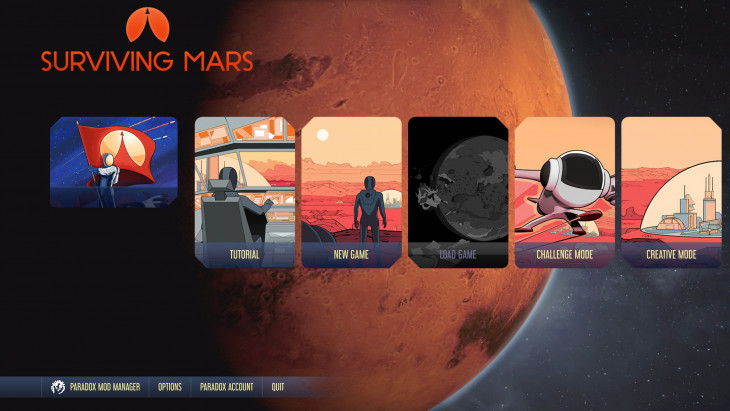
You have been tasked as the manager of the first colony on Mars. You are funded and assisted by a company on Earth, and will work with scientists from time to time. But for the most part, you alone decide how to manage the first colony on the red planet. Will you make Mars a utopia for interstellar colonists? Or will your missions be doomed to failure? Your choice of location and the layout of your colony will make all the difference between life and death.
But don't fret, governor. As you start the game you will have plenty of time to play through tutorials. They will help give the very basics of the game, from basic controls and how to build, to tips on how to build your colony to be efficient. The beginning of the colony doesn't matter too much, as it's pretty simple to rebuild minor aspects of the colony. But as the colony grows, layout and materials will play a huge role in the colonies success.
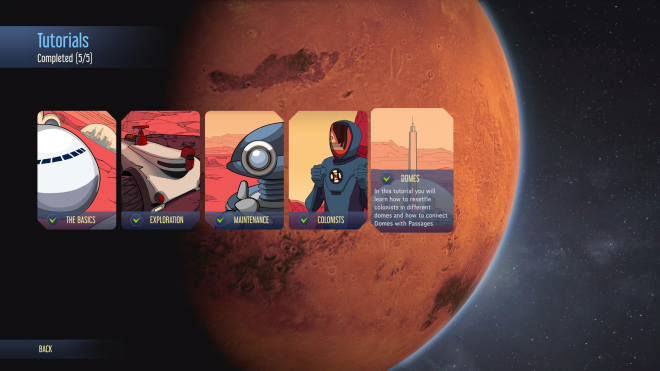
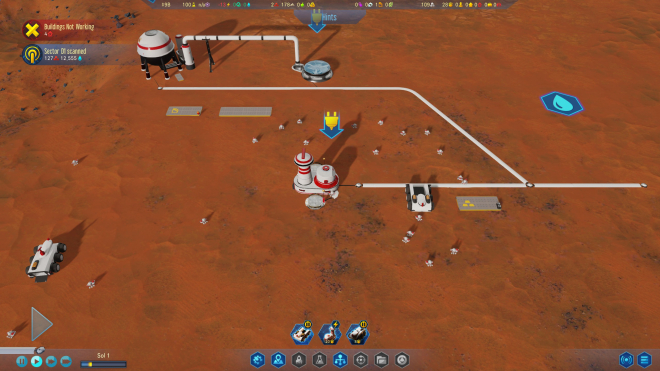
After selecting the landing spot for the initial rocket, you can choose exactly where on the map the ship will land. The colony starts with some initial resources and drones, which you will use to start building the colony. The early stages of the colony will pave the way for the success of the colony. The location, the layout, the initial buildings and resources, all of these matter to survive.
Select your landing zone, touch down, and start building. Each zone will have its own difficulties. Some zones will have dust storms, some will be more prone to meteor strikes, and some will have more or less of certain materials. It's important to select places that will have plenty of the initial resources, as it's difficult to even make it far enough to mine more refined materials if you're missing or short on the basic necessities. Wise planning will go a long way to help make it to late game.
Once you get your initial colony established, you'll start building domes. As the natural landscape is barren and dangerous, domes are necessary in order to bring people from Earth. You'll have an assortment of buildings to add, from apartments and houses, farming areas, stores, and so forth. For the initial shuttle or two you'll only need the basic necessities in order to progress, but you need to make sure that you have enough space for all the new colonists while not having too much extra of anything.
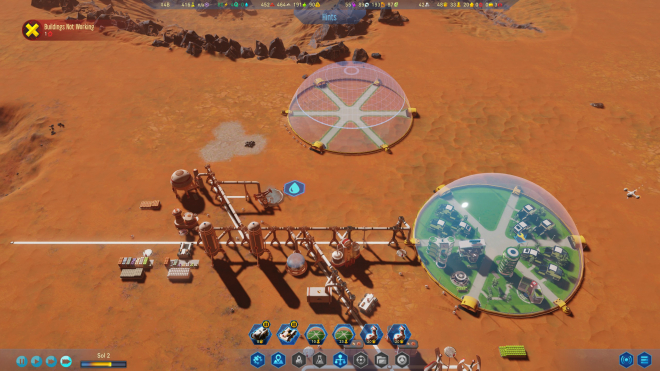
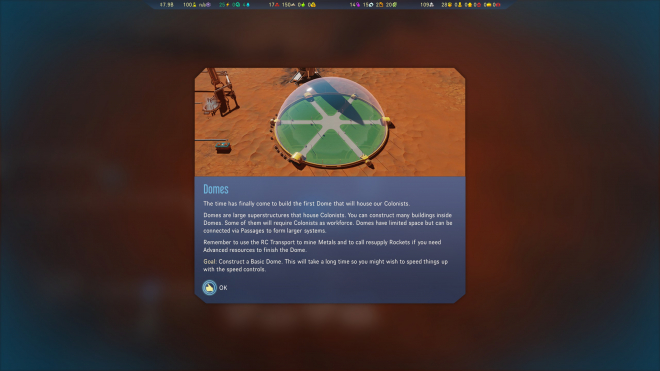
As you grow the game can provide additional tips to help ease the growing pains. New players will find them helpful so that they know how to better manage their resources and personnel. Along with tips, you will periodically get requests from the colonists to help settle disputes or decide certain courses of action. Will you allow religion to reign supreme in your colony? Will you allow scientists extra privileges in order to get more research completed? Will you allow an AI access to your computer systems? Each of this and more will effect your colony and how it grows and develops.
In order to progress, you need to do research. You can only do research once you get colonists on Mars, and each research takes a different amount of time to complete. There are different lines of research that will help the colony grow in different ways. Certain buildings or researches are only be made available as you complete earlier research. You'll find that many times the research will be where you need the most help, whether it be in power generation, food production, or the longevity of the drones or buildings, and so on and so forth. At the end of each tree there is a special building or wonder. Each wonder has a specific benefit to the colony. They take a ton of time and materials to build but they pay off magnificently when you have them.
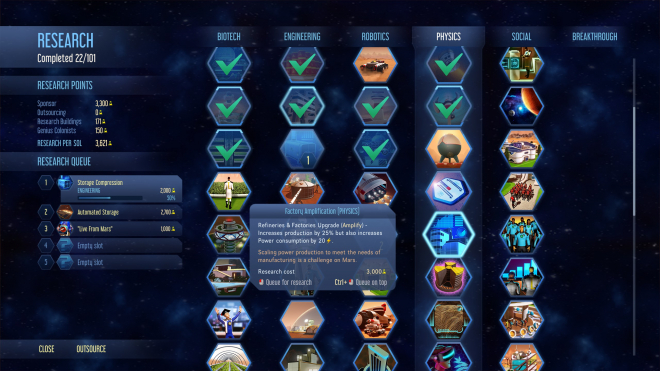
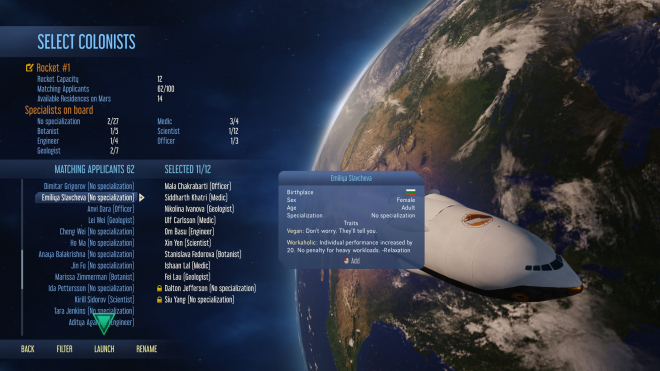
After the colony is ready for people, you can request colonists from Earth. One amazing part of this game is that you can select colonists from a list of people. Each colonist has their own personality, their own pros and cons, their strengths, likes, and weaknesses. As you select the colonists it's important to select the ones that you need most, at least at first. Later in the game you can send shuttles with whatever you'd like as you can train the colonists at universities. Eventually, if you want, you can build a nursery where babies can be raised. Be careful as to who you bring to Mars, as some colonists can cause problems on the red planet. But if they do, make sure to build security stations to maintain the peace.
As the colony grows you'll experience growing pains. With new buildings, colonists, and perks, the layout of the buildings will start to have a major influence with how the colony keeps growing. If the resources are at one side of the colony when they are needed on the other side, building will be difficult. But if the resources and layout are done well and with forethought, growing won't be as much of an issue. Leaving space for the addition of new buildings, or allowing for additional production to keep up with needs, can help ease future issues. But be careful with how much space you allow, as it can get expensive to maintain the buildings.
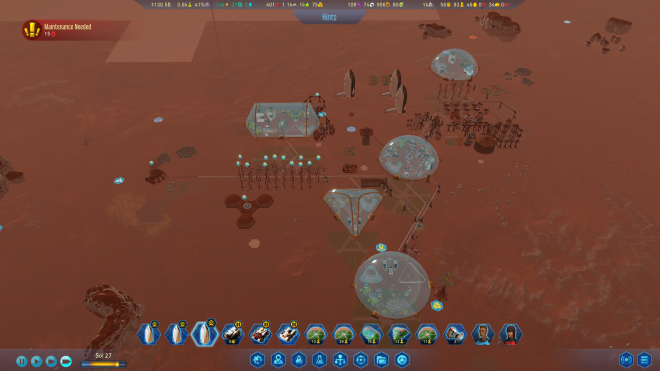
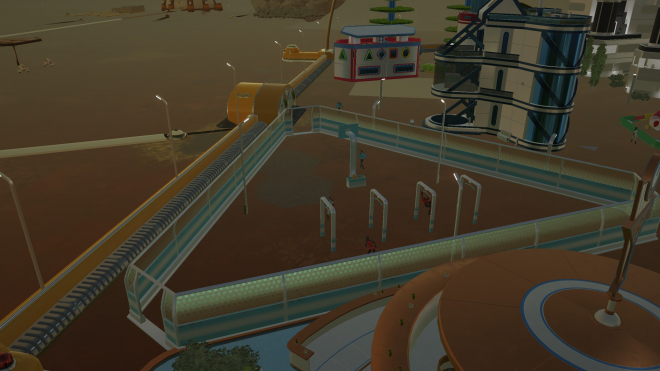
One fun part of the game is the visuals. In a game where you are building a colony it's important that you're able to see what you're doing. Surviving Mars is one of the few games I've seen or played where the game is entirely 3 dimensional. You can rotate the camera to see it from the top or from a shallow angle. You can also rotate the game to see behind buildings, in order to make sure they are connected correctly or plan out pathing for drones or transports. You can also watch from the perspective of a drone, a ship, or from a colonist. It gives the entire game a different feel when being able to see it from the colonist's point of view. There's not much use to it as it doesn't offer a major benefit to the colony, but it's a fun bonus none-the-less.
While you're building the colony you will have access to the region where you settled via the main map. You'll use satellites to scan the different sectors for different resources. It's important to keep scanning the sectors in order to see where the best resources are. Seeing what resources are available can dictate where and how you would progress the colony. As the research progresses down the trees you may be able to scan for new resources, which can help dictate your next actions. Ignoring the map and the scanning is a surefire way to miss out on resources and opportunities.
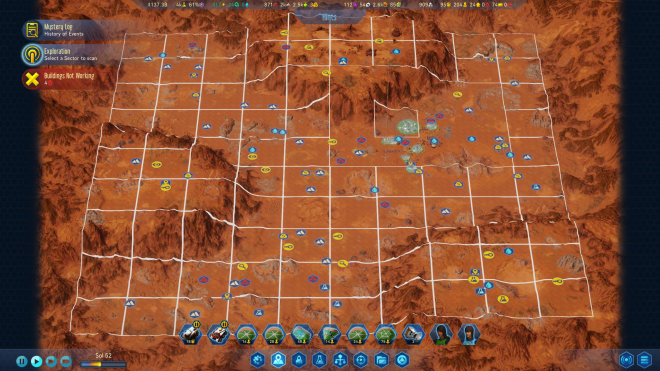
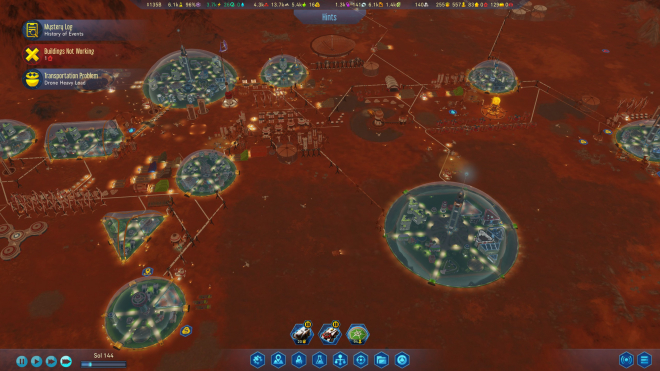
In the end, if you build the colony right, it's just a matter of ever-expanding the colony. Later in the game you'll have access to bigger and better buildings, like miniature suns for energy, massive tools for mining, and automated production so you won't need people to do the menial jobs. Depending on how you built the colony it'll end in glory as it becomes an ever increasing utopia or it could go down in flames and destruction as you mis-managed the project as a whole. Be careful with what you do, as a minor choice early on can cause no end of grief later down the road.
Whether you're playing the game casually or hardcore this game is entertaining. It's a great up-to-date, challenging, and well rounded colony and resource management game that will help teach you how to play or new skills as you progress. It can be unforgiving at times, but if you're wanting to be better at these type of games this will help you learn new tricks and talents. From managing resources, to keeping the colony alive, to managing people, jobs, and construction projects, this game can help teach a lot. The easier difficulties can help ease you into the game as it can be relaxing to see your colony grow and take shape, while the more difficult settings can make you want to cry as you try to keep everything together with meager scraps.
This game is great for those who love colony management games. It's as casual or as difficult as the player wants it to be. Each map and play-through will have it's own unique challenges, so no two maps will be the same. Even if you don't love the genre, this is a great game to have in your library. If you like this genre, definitely get this game. If it seems even remotely interesting, if it's on sale, get it. The controls are easy to learn, so it doesn't have a steep learning curve in order to grasp how to play. It's well worth at least a few rounds. Hey, you may even learn something while playing!
AUTHOR INFORMATION

 The music in this game is quite entertaining. It fits the gameplay well and doesn't distract. You can choose from no music or from a variety of "space" stations.
The music in this game is quite entertaining. It fits the gameplay well and doesn't distract. You can choose from no music or from a variety of "space" stations.
 The controls are a little difficult to learn but are easy to use once you learn them. Basically everything you need to play the game is easily available.
The controls are a little difficult to learn but are easy to use once you learn them. Basically everything you need to play the game is easily available.
 This game can be as easy or as difficult as you want to make it. Before starting a new game you can select from a massive variety of game options, each of which will make the game easier or more difficult.
This game can be as easy or as difficult as you want to make it. Before starting a new game you can select from a massive variety of game options, each of which will make the game easier or more difficult.
 Although the game may be similar in the beginning, each time you start a new colony it brings with it a host of new challenges.
Although the game may be similar in the beginning, each time you start a new colony it brings with it a host of new challenges.
 There is a little bit of a story to this game. It has over-arching plots depending on what you select. Early decisions can make a huge difference on late-game play, so be careful with your choices.
There is a little bit of a story to this game. It has over-arching plots depending on what you select. Early decisions can make a huge difference on late-game play, so be careful with your choices.
PROS / CONS
- Variable levels of difficulty
- 3D maps
- Easy to learn controls
- Beautiful graphics
- Full control over the colony
- Easy to make major mistakes
- Music can get monotonous
- AI can be a little glitchy
- Little plot
- Progression can be slow

